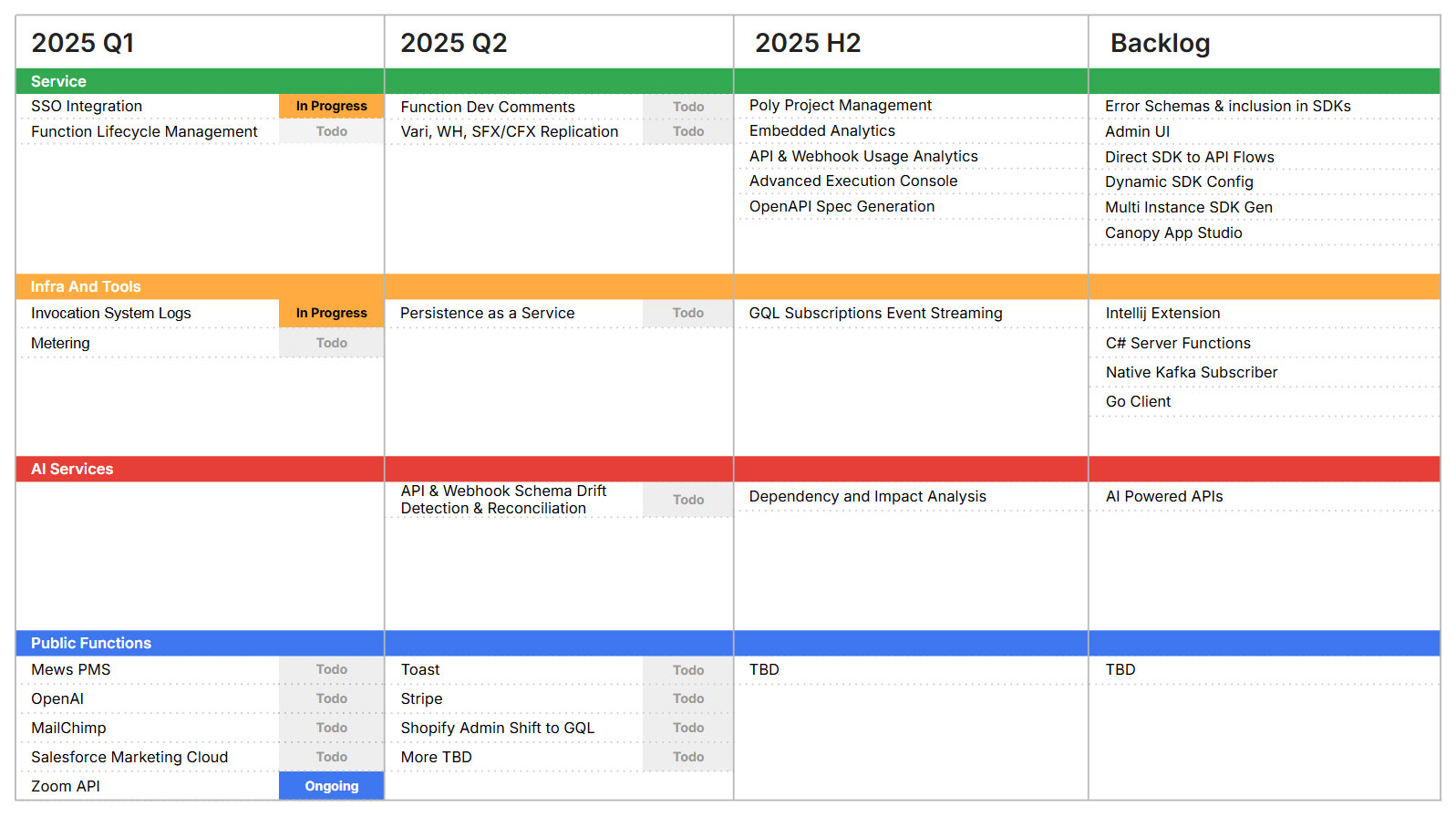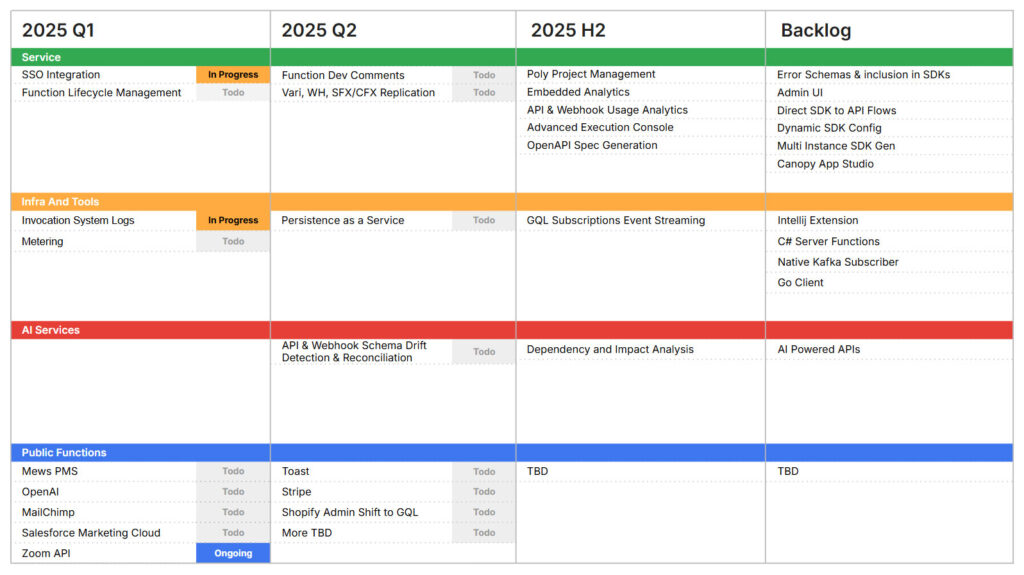It’s good to have a plan, even if the plan evolves over time. Our 2025 roadmap is shaped by current market needs and emerging opportunities. At PolyAPI, we value transparency with our customers, prospects, partners, and the broader community. While we plan for the next 12 months, we’re always thinking further ahead.
This roadmap focuses on net new capabilities and features that enhance the platform’s overall power. It’s intentionally lean to maintain a deep focus on providing top-tier service and supporting our customers, both platform users and those who have engaged us for end-to-end solutions. Many small improvements aren’t listed here, and numerous features will have ongoing development after their initial release. Our agile development approach prioritizes iterative progress, which can be challenging to represent in a static roadmap. For the latest updates, visit our publicly available roadmap at PolyAPI Roadmap.
We’ve provided brief, clear descriptions of each feature to keep this post concise. If you’d like to learn more about any specific feature, please email us at hello@polyapi.io or fill out a contact form on our website.

Roadmap States
- Todo: Not yet started.
- In Progress: Development work has started, but it has not yet been released.
- Ongoing: The feature has been released, but iterative improvements are actively in progress.
- Completed: The feature has been completed to a sufficient degree for the time being.
Key Focus Areas for Q1
- SSO Integration: Support native OIDC providers using Auth Providers in Poly. This will enable token-based access for logging into Canopy and API access secured by tokens issued by a customer’s own IDP. Configuration will be done on a per-tenant basis.
- Function Lifecycle Management: Introduce states for all functions (e.g., DRAFT to DEPRECATED) to manage function lifecycle. This system will recommend which replacement function should be used, with states and replacements reflected in SDKs and made available as context to our AI Assistant.
- Invocation System Logs: Currently, logs written by server functions are visible to the developers of those functions, but Gateway logs are not. This new capability will allow Gateway logs to be collected and made accessible to developers with appropriate permissions.
- Metering: Enable tracking and reporting of PolyAPI usage for both Poly’s billing and customer awareness of their own function usage.
- New Out-of-the-Box (OOB) API Functions & Webhooks: Train and introduce support for Mews, OpenAI, MailChimp, Salesforce Marketing Cloud, and additional Zoom APIs, depending on OpenAPI spec availability.
Key Focus Areas for Q2
- Function Developer Comments: Allow developers to write notes about functions, either privately or publicly, with comments displayed in the UI and provided as context for the AI Assistant. We’re also exploring AI-generated or AI-assisted comments.
- Replication of Variables, Webhooks, Server, and Client Functions: Expand existing replication capabilities to cover other objects, including the potential for environment-level replication to synchronize entire environments.
- Persistence as a Service: Offer a simple, built-in database to support composite applications and integrations, eliminating the need for customers to provide their own in cases where persistence is needed. This may also include a cache service, and access will be similar to how variables are used today, with native operations for each defined table.
- API & Webhook Schema Drift Detection and Reconciliation: Introduce a service to analyze runtime traffic against API and webhook schemas. The system will flag differences and propose updates to the schema. This service may leverage excess cluster capacity during idle times or could be offered as an add-on based on infrastructure costs.
- New Out-of-the-Box (OOB) API Functions & Webhooks: Focus on training for Toast, Shopify GQL Admin API, and Stripe, with additional functions identified based on customer demand.
Key Focus Areas for H2
- Poly Project Management: Organize integration components (API functions, custom functions, variables, etc.) into a project view that provides descriptions and visualizes dependencies. We aim to use systematized knowledge capture to automate project creation and categorization.
- Embedded Analytics: Bring current Grafana dashboards directly into the Poly management UI, enabling customers to see tenant-specific analytics and statistics.
- API & Webhook Usage Analytics: Extend analytics to include API functions and webhooks, providing the same depth of insight currently available for server functions.
- Advanced Execution & Training Console: Enhance function invocation capabilities in the UI by enabling saved calls, shared calls, and other standard execution console features. We’re also exploring inline training of new functions from within the UI. With this capability you will be able to call 1000s of API endpoints right from your mobile phone!
- OpenAPI Spec Generation: Offer OpenAPI spec generation for Poly-exposed endpoints, enabling customers to generate specs as they create new APIs.
- Native GraphQL Subscription Event Streaming: Simplify event streaming for OHIP Event Streaming by adding configuration-driven listeners for GraphQL subscriptions. The Poly Gateway will manage connections, subscriptions, and event handling for users.
- Dependency and Impact Analysis: Build on schema drift detection with tools to analyze server function dependencies and assess the impact of changes. Alerts will be generated to flag potential issues, enabling quick impact analysis and smarter version migration.
- New Out-of-the-Box (OOB) API Functions & Webhooks: These will be determined based on customer demand and emerging opportunities.
Backlog
- Error Schemas and Inclusion in SDKs: Enable server-stored error information to be reflected in SDKs and the management UI. Runtime-detected errors will automatically be suggested for inclusion in function error responses.
- Admin UI: Expand admin capabilities in the UI, including managing configuration variables, enabling MFA, and more.
- Direct SDK-to-API Flows: For customers interested in Poly solely as an SDK generation tool, this feature will allow SDKs to call APIs directly, bypassing the Poly Gateway.
- Dynamic SDK Configuration: Enable SDKs to be dynamically reconfigured via responses from the Poly Gateway, supporting self-hosted instances and environment migrations.
- Multi-Instance SDK Generation: Allow Poly clients to be built against multiple instances of Poly, enabling larger enterprises and Poly customers to access endpoints from other Poly customers.
- Canopy App Studio: Introduce a user-friendly editor for creating and managing custom Canopy apps, likely as another Canopy app itself.
- C# Server Functions: Add support for writing and deploying server functions in C#, in addition to existing support for C# API functions.
- Native Kafka Subscriber: Enable Poly Gateway to subscribe to Kafka topics and deliver events to clients or trigger server functions, mirroring existing webhook support.
- Go Client & SDK Generation: Add support for Go, one of our top customer requests, allowing Go developers to consume API and server functions similar to our existing support for C#.
- AI-Powered APIs: Explore an AI-powered layer for API invocations. This layer would front a set of APIs and allow prompt-based invocation, enabling AI agents to introspect and interact with available functions.
Get In Touch With Us
We hope this roadmap provides valuable insight into our plans for 2025 and beyond. If you’re excited by what you see, please reach out to us at hello@polyapi.io or book an intro call with Jake at Jake’s Calendly. For the most up-to-date roadmap, visit PolyAPI Roadmap.
